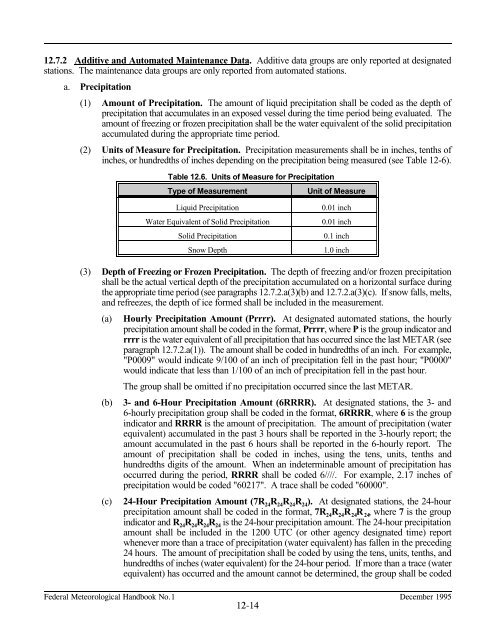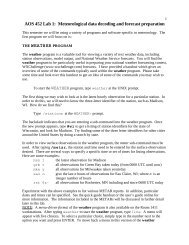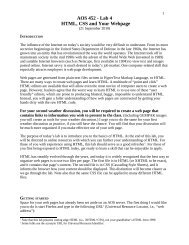Federal Meteorological Handbook No. 1 - Marrella
Federal Meteorological Handbook No. 1 - Marrella
Federal Meteorological Handbook No. 1 - Marrella
Create successful ePaper yourself
Turn your PDF publications into a flip-book with our unique Google optimized e-Paper software.
12.7.2 Additive and Automated Maintenance Data. Additive data groups are only reported at designated<br />
stations. The maintenance data groups are only reported from automated stations.<br />
a. Precipitation<br />
(1) Amount of Precipitation. The amount of liquid precipitation shall be coded as the depth of<br />
precipitation that accumulates in an exposed vessel during the time period being evaluated. The<br />
amount of freezing or frozen precipitation shall be the water equivalent of the solid precipitation<br />
accumulated during the appropriate time period.<br />
(2) Units of Measure for Precipitation. Precipitation measurements shall be in inches, tenths of<br />
inches, or hundredths of inches depending on the precipitation being measured (see Table 12-6).<br />
Table 12.6. Units of Measure for Precipitation<br />
Type of Measurement Unit of Measure<br />
Liquid Precipitation 0.01 inch<br />
Water Equivalent of Solid Precipitation 0.01 inch<br />
Solid Precipitation 0.1 inch<br />
Snow Depth 1.0 inch<br />
(3) Depth of Freezing or Frozen Precipitation. The depth of freezing and/or frozen precipitation<br />
shall be the actual vertical depth of the precipitation accumulated on a horizontal surface during<br />
the appropriate time period (see paragraphs 12.7.2.a(3)(b) and 12.7.2.a(3)(c). If snow falls, melts,<br />
and refreezes, the depth of ice formed shall be included in the measurement.<br />
(a) Hourly Precipitation Amount (Prrrr). At designated automated stations, the hourly<br />
precipitation amount shall be coded in the format, Prrrr, where P is the group indicator and<br />
rrrr is the water equivalent of all precipitation that has occurred since the last METAR (see<br />
paragraph 12.7.2.a(1)). The amount shall be coded in hundredths of an inch. For example,<br />
"P0009" would indicate 9/100 of an inch of precipitation fell in the past hour; "P0000"<br />
would indicate that less than 1/100 of an inch of precipitation fell in the past hour.<br />
The group shall be omitted if no precipitation occurred since the last METAR.<br />
(b) 3- and 6-Hour Precipitation Amount (6RRRR). At designated stations, the 3- and<br />
6-hourly precipitation group shall be coded in the format, 6RRRR, where 6 is the group<br />
indicator and RRRR is the amount of precipitation. The amount of precipitation (water<br />
equivalent) accumulated in the past 3 hours shall be reported in the 3-hourly report; the<br />
amount accumulated in the past 6 hours shall be reported in the 6-hourly report. The<br />
amount of precipitation shall be coded in inches, using the tens, units, tenths and<br />
hundredths digits of the amount. When an indeterminable amount of precipitation has<br />
occurred during the period, RRRR shall be coded 6////. For example, 2.17 inches of<br />
precipitation would be coded "60217". A trace shall be coded "60000".<br />
(c) 24-Hour Precipitation Amount (7R R R R ). At designated stations, the 24-hour<br />
24 24 24 24<br />
precipitation amount shall be coded in the format, 7R R R R , where 7 is the group<br />
24 24 24 24<br />
indicator and R R R R is the 24-hour precipitation amount. The 24-hour precipitation<br />
24 24 24 24<br />
amount shall be included in the 1200 UTC (or other agency designated time) report<br />
whenever more than a trace of precipitation (water equivalent) has fallen in the preceding<br />
24 hours. The amount of precipitation shall be coded by using the tens, units, tenths, and<br />
hundredths of inches (water equivalent) for the 24-hour period. If more than a trace (water<br />
equivalent) has occurred and the amount cannot be determined, the group shall be coded<br />
������������������������������������ �������������<br />
�����





